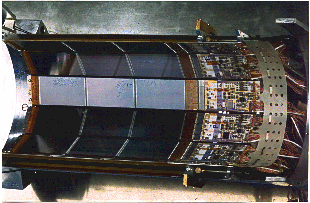The OPAL Silicon MicroVertex Detector
The central detector of OPAL had the task of making precise measurements of the trajectories of charged particles. It consisted of four components, of which the innermost was the silicon microvertex detector. The purpose of the silicon detector was to provide very accurate measurements of particle trajectories very close to the interaction point. This allowed us to recognise the formation of very short lived particles, especially the tau lepton, and hadrons containing b-quarks. Such B-hadrons have lifetimes of around 1 picosecond, and thus travel a few millimetres on average before decaying. The identification of their decays is a valuable way of tagging b-quarks.
The microvertex detector, in the design and construction of which Cambridge played a leading role, consisted of two barrels of silicon microstrip detectors. The silicon detectors are 250 or 300 microns thick, and when charged particles traverse them, electron-hole pairs are formed. The electrons may be drifted to implanted strips of width 25 microns, and thus the track position accurately determined. Multiplexing electronics is bonded to the end of the detectors.
The original OPAL silicon detector was installed in 1991, and consisted of 25 ladders, each of three detectors, arranged in two cylindrical barrels at radii 6.1 and 7.5 cm around a thin beryllium beam pipe. The intrinsic resolution of the detectors was about 5 microns, with an effective precision of about 10 microns achieved within OPAL. In the original detector, only two dimensional readout was performed, but an updated detector in 1993 consisted of pairs of detectors with orthogonal strips placed back-to-back, in order to provide three-dimensional readout. A further upgrade took place in 1995-6 in which the geometry was modified to eliminate some of the gaps between adjacent detectors and to length the detector acceptance in z.
The picture above shows half of the microvertex detector. Two such hemi-cylinders are joined about the beryllium beam pipe within which the beams collide.

